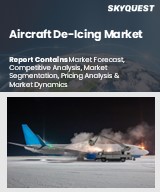
Report ID: SQMIG20S2025
Skyquest Technology's expert advisors have carried out comprehensive research on the aircraft de-icing market to identify the major global and regional market trends and growth opportunities for leading players and new entrants in this market. The analysis is based on in-depth primary and secondary research to understand the major market drivers and restraints shaping the future development and growth of the industry.
Growing Number of Flights in Areas with Cold Climates
Basing more Importance on the Rules that Pertain to Flight Safety
Detrimental Effect of De-Icing Liquids on the Environment
High Costs on Operations and Requirement for Infrastructure
REQUEST FOR SAMPLE
Global Aircraft De-Icing Market size was valued at USD 1.60 Billion in 2023 and is poised to grow from USD 1.67 Billion in 2024 to USD 2.39 Billion by 2032, growing at a CAGR of 4.6% in the forecast period (2025-2032).
Textron, UTC Aerospace Systems, and BASF are leading market players in the industry, investing in strategic alliances and product enhancement. This clearly shows that the market is reasonably concentrated. By improving glycol recycling systems and self-propelled spray booms, the market participants are making some strides towards achieving a more sustainable future. These relationships with the defense industry are in turn promoting adoption within nations such as Germany and the United States. There is also a shift of firms into the APAC regions, where they are making product-specifications to meet a range of climate-specific issues. 'Air Canada', 'Vestergaard Company', 'Equipmake', 'Vestergaard Company', 'UTC Aerospace Systems (now Collins Aerospace)', 'Kilfrost Ltd.', 'JBT Corporation', 'Global Ground Support LLC', 'LyondellBasell Industries Holdings B.V.', 'Inland Technologies', 'Cryotech Deicing Technology', 'Radiant Aviation Services', 'Safran SA', 'John Bean Technologies Corp', 'Dow Inc.'
Growing demand for de-icing products is being stimulated by increasing aviation traffic in areas of North America, Europe, and Asia where it snows. To enable big airports such as O'Hare, Frankfurt, and Tokyo Narita to continue operating as usual during the winter months, de-icing is a crucial element of ground handling. The sheer number of as many as 700 de-icing operations that Minneapolis–Saint Paul International Airport undertakes daily during peak winter months is an example of how demand for service boosts market growth.
Implementation of Fluids Both Biodegradable and Environmentally Friendly: The air transport industry is going for increased sustainability, leading to companies making investments in environmental-friendly solutions. Clariant and Kilfrost, for example, have designed de-ice solutions that are bio-based, non-hazardous, and suitable in terms of the criteria currently set as it concerns environmental impact. These fluids, which minimize the harmful effect on the environment while not sacrificing performance, are used by airports across Europe and Canada, who are leaders in utilizing them.
How Is De-Icing Shaping Aviation in North America?
Want to customize this report? This report can be personalized according to your needs. Our analysts and industry experts will work directly with you to understand your requirements and provide you with customized data in a short amount of time. We offer $1000 worth of FREE customization at the time of purchase.
Feedback From Our Clients

Report ID: SQMIG20S2025
sales@skyquestt.com
USA +1 351-333-4748